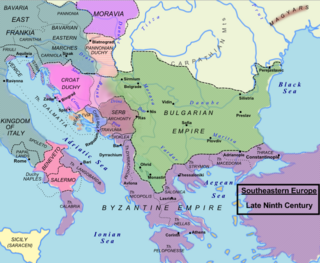
Milazzo is a town (comune) in the Metropolitan City of Messina, Sicily, southern Italy; it is the largest commune in the Metropolitan City after Messina and Barcellona Pozzo di Gotto. The town has a population of around 31,500 inhabitants.

Year 888 (DCCCLXXXVIII) was a leap year starting on Monday of the Julian calendar.

The Byzantine navy was the naval force of the East Roman or Byzantine Empire. Like the empire it served, it was a direct continuation from its Imperial Roman predecessor, but played a far greater role in the defence and survival of the state than its earlier iteration. While the fleets of the unified Roman Empire faced few great naval threats, operating as a policing force vastly inferior in power and prestige to the legions, the sea became vital to the very existence of the Byzantine state, which several historians have called a "maritime empire".

The second Arab siege of Constantinople in 717–718 was a combined land and sea offensive by the Muslim Arabs of the Umayyad Caliphate against the capital city of the Byzantine Empire, Constantinople. The campaign marked the culmination of twenty years of attacks and progressive Arab occupation of the Byzantine borderlands, while Byzantine strength was sapped by prolonged internal turmoil. In 716, after years of preparations, the Arabs, led by Maslama ibn Abd al-Malik, invaded Byzantine Asia Minor. The Arabs initially hoped to exploit Byzantine civil strife and made common cause with the general Leo III the Isaurian, who had risen up against Emperor Theodosius III. Leo, however, tricked them and secured the Byzantine throne for himself.
Abu Ishaq Ibrahim II ibn Ahmad was the Emir of Ifriqiya. He ruled from 875 until his abdication in 902.
Euphemius or Euphemios was a Byzantine commander in Sicily, who rebelled against the imperial governor in 826 CE, and invited the Aghlabids to aid him, thus beginning the Muslim conquest of Sicily.

The history of Islam in Sicily and Southern Italy began with the first Arab settlement in Sicily, at Mazara, which was captured in 827. The subsequent rule of Sicily and Malta started in the 10th century. The Emirate of Sicily lasted from 831 until 1061, and controlled the whole island by 902. Though Sicily was the primary Muslim stronghold in Italy, some temporary footholds, the most substantial of which was the port city of Bari, were established on the mainland peninsula, especially in mainland Southern Italy, though Muslim raids, mainly those of Muhammad I ibn al-Aghlab, reached as far north as Naples, Rome and the northern region of Piedmont. The Muslim raids were part of a larger struggle for power in Italy and Europe, with Christian Byzantine, Frankish, Norman and local Italian forces also competing for control. Muslims were sometimes sought as allies by various Christian factions against other factions.

The Muslim conquest of Sicily began in June 827 and lasted until 902, when the last major Byzantine stronghold on the island, Taormina, fell. Isolated fortresses remained in Byzantine hands until 965, but the island was henceforth under Muslim rule until conquered in turn by the Normans in the 11th century.
Nasar, originally baptized Basil, was a distinguished Byzantine military leader in the Byzantine–Arab conflicts of the latter half of the 9th century.

The siege of Syracuse in 877–878 led to the fall of the city of Syracuse, the Roman capital of Sicily, to the Aghlabids. The siege lasted from August 877 to 21 May 878, when the city, effectively left without assistance by the central Byzantine government, was sacked by the Aghlabid forces.

The navy of the Fatimid Caliphate was one of the most developed early Muslim navies and a major military force in the central and eastern Mediterranean in the 10th–12th centuries. As with the dynasty it served, its history can be distinguished into two phases. The first period, from c. 909 to 969, when the Fatimids were based in Ifriqiya, and the second period, lasting until the end of the dynasty in 1171, when the Fatimids were based in Egypt. During the first period, the navy was employed mainly in the constant warfare with the Byzantine Empire in Sicily and southern Italy, where the Fatimids enjoyed mixed success, as well as in the initially unsuccessful attempts to conquer Egypt from the Abbasids and the brief clashes with the Umayyad Caliphate of Córdoba.

The Battle of Stelai was a naval battle fought in 880 between the Byzantine and Aghlabid fleets off the southern Italian peninsula. The battle was a major Byzantine victory. Its location is disputed, hence it is also known as the First Battle of Milazzo or the Battle of Punta Stilo in modern literature.

The Battle of Cephalonia was a naval battle fought between the Byzantine and Aghlabid fleets near Cephalonia, off the western coast of Greece. The battle was a major Byzantine victory, and one of the rare naval battles that took place during the night in the Middle Ages.

The Siege of Ragusa by the Aghlabids of Ifriqiya lasted for fifteen months, beginning in 866 until the lifting of the siege at the approach of a Byzantine fleet in 868. The failure of the siege and the re-appearance of the Byzantines in the region of Dalmatia signalled the beginning of new aggressive western policy by the new Byzantine emperor, Basil I. Its immediate effects were the re-establishment of Byzantine authority there in the form of the Theme of Dalmatia, and the beginning of the Christianization of the Slavs of the western Balkans, but within a few years it led to renewed Byzantine involvement and presence in southern Italy as well.

The Battle of Kardia was a naval battle fought in c. 872/3 between the fleets of the Byzantine Empire and the Cretan Saracens off Kardia, in the Gulf of Saros. The battle was a major Byzantine victory.

The Battle of the Straits was fought in early 965 between the fleets of the Byzantine Empire and the Fatimid Caliphate in the Straits of Messina. It resulted in a major Fatimid victory, and the final collapse of the attempt of Emperor Nikephoros II Phokas to recover Sicily from the Fatimids.
Al-Ḥasan ibn al-ʿAbbās was an Aghlabid military commander who fought in Sicily against the Byzantine Empire.
The Battle of Caltavuturo was fought in 881 or 882 between the Byzantine Empire and the Aghlabid emirate of Ifriqiya, during the Muslim conquest of Sicily. It was a major Byzantine victory, although it could not reverse the Muslim conquest of Sicily.

The Siege of Taormina in 902 ended the conquest of the Byzantine city of Taormina, in northeastern Sicily, by the Aghlabids. The campaign was led by the deposed Aghlabid emir, Ibrahim II, as a form of armed pilgrimage and holy war. Ibrahim's forces defeated the Byzantine garrison in a hard-fought battle in front of the city walls, and laid siege to the city. Left unsupported by the Byzantine government, Taormina capitulated on 1 August. The population was massacred or sold into slavery. The fall of this last major Byzantine stronghold signalled the completion of the Muslim conquest of Sicily, which had been ongoing since the 820s, although some minor Byzantine outposts survived until the 960s.










